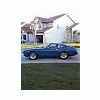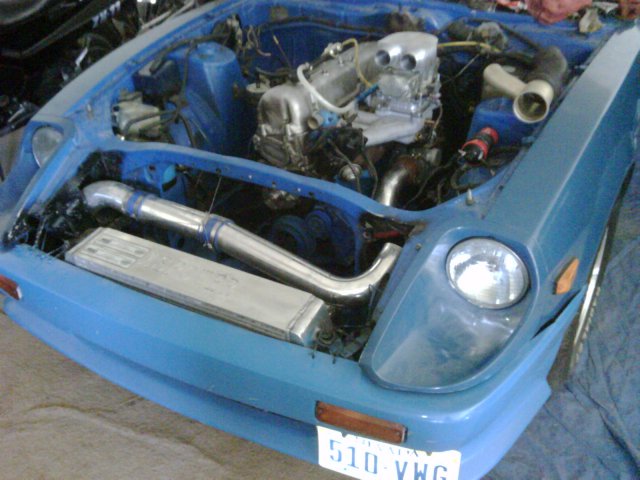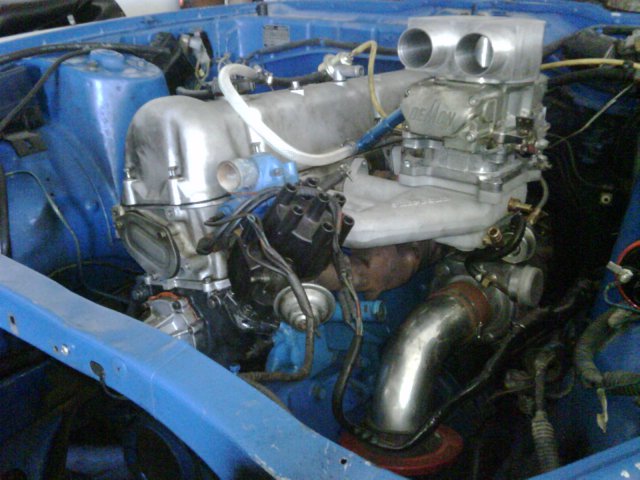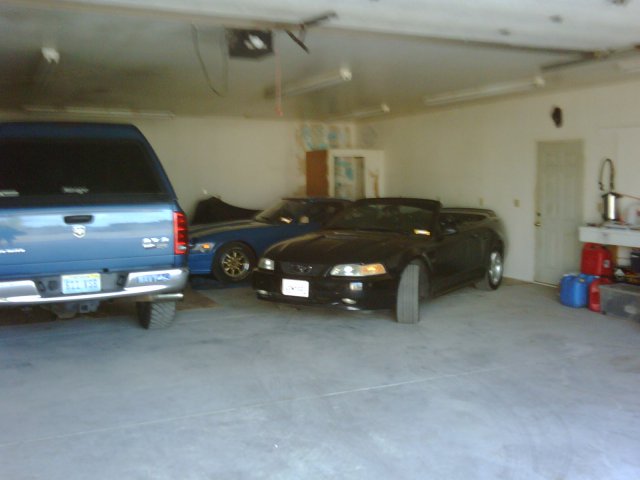-
Posts
38 -
Joined
-
Last visited
Content Type
Profiles
Forums
Blogs
Events
Gallery
Downloads
Store
Everything posted by madmatt48
-
Well here is the latest on project 79 ZX that has been on the back burner for sometime due to job hunting in this great economy.... Finally found a job, home with a garage (my priority in home purchase) and can now continue my Frankenstein project Z (hence the stitches you may see up close) Enclosed are the latest pictures over the weekend mocking up the clifford manifold, T04e, Demon, new head and carb hat. Now that most of the mockup is done, I will take the intake manifold off again, relocate the internal wastegate on the T04e since the bracket holding it was contacting the bottom of the intake manifold in its current location. Should have a test fire and if that goes well, a test and tune at Top Gun Raceway in Fallon sometime September or October if all tests are a go. Depending on how this works out will determine if I will still add the paxton supercharger in tandum to the mix. After all, this car is just for fun and by no means a daily driver.
-
Yes, pulling the oil pan for maintenance, not much clearance have done it twice with my S-130 1979 280zx. I have dissassembled a few engines to the block for parts or piston/rod inspection while they are still bolted to the engine mounts due to not having a cherry picker at the time. You could get to some of the crank removal points, but to pull the crank, you need to remove all your engine accessories, head, driveshaft, transmission, clutch, pressure plate, flywheel, crank pulley, timing front cover (did I miss anything) out of the way to gain access to all the crank removal points. Now if you get the car up on strong stable jackstands, support the engine's weight by placing a large block or another stable jack stand under the front of the transmission where it meets the engine, you could then remove the front crossmember and steering rack as an assembly and get enough access to remove the crank. In my opinion, with all the work I just described above just to get to the crank with the engine still in the car, removing the engine as an assembly and placing it on a work stand is the best way to go. Hope this helps.
-
I have not used the profec-a boost controller however, I have had great experiences with the Greddy profec-b series boost controller in two R-32 Skyline GT-R's with both stock twin turbos with internal wastegates, a T-88-34D and T51-kai single turbines both with external wastegates. Both above applications I used the same profec-b boost controller (after adjusting dip switches and boost lines) with outstanding boost consistency, no spikes with boost backing down to stock or below. It is also a very easy boost controller to set up and use. Its simple on/off switch, low/high boost selection switch and a knob for each to precisely set until you find the boost that fits your range of engine modifications and fuel flow is great. I had the problem you are describing above where the boost starts off hard(spikes up)where you have set your boost and then suddenly just backs off to stock or less than stock boost(very frustrating especially in a 0-400 meter race) I had that problem, just with a different brand/style of electronic boost controller, the HKS EVC. In no way am I knocking a specific brand of boost controller, it just happened to be that brand I had the problem with. That boost controller, during the time I was running the RB26DETT with the stock twin turbines(internal wategates). I tried several things, changing out the EVC control unit, the vacuum control unit(used parts), checking/adjusting all my boost and vacuum lines many times, same results. Basically after I bought a new (never installed) Greddy profec-b, from Bee Racing(in Japan) that was the last time I had that problem and it was the last boost controller I ever bought new for the two GT-R's I tuned (1989 and 1992 R-32). I used the same profec-b when I converted both to single turbines with external wastegates (T51 kai on the 1992, T-88-34D on the 1989) with the same consistent results. With all of the above being said, perhaps if I had bought the HKS EVC brand new in the box instead of getting it used, I most likely would not have had the above described problems and it would have worked as advertised. In my experience I have found that purchasing used electronic boost controllers is a hit and miss thing. Some controllers have a long service life and others work for just a few years. My recommendation is purchasing electronic boost controllers new. After all, they come with all the instructions(where to set the dip switches on the back of the for either external or internal wategates), settings and hardware. Here is a link you can check out see if it helps: http://www.fd3s.net/profec_install.html I know the link says its for FD rx-7s but it has a universal profec-a or b boost controller settings page that is descriptive in setting up controllers. Hope this helps you with your current or future boost controller. Good luck and please do post what ends up fixing your boost problem for all of us to benefit and learn from.
-
Has anybody out there tried running t3/t4 turbo charger through a blow through Demon 4-barrel carburator mounted on a clifford 4-barrel manifold on an L-28? If so, how were the results in hp and torque? If there is a past thread on this, could you all help direct me to it? A lot of the domestics are running Demons with big single and twin t3/t4 turbines with powerful results. Figured it should flow well due to the large inlet area and how the Demon compensates with extra fuel for every pound of boost blowing through it. This is the combination I will try first before attempting to run a supercharger tandum with it. Any info on this would be apprieciated.
-
This is my project Z that I picked up for $500.00 in Fresno California November 2005. Its the first left hand S-130 Z car I have owned. I have owned several right hand Z cars in the course of the 16 years I had lived and served overseas in Japan (1989-2005). This particular Z had wiring issues, electrical system charging issues, water intrusion, an automatic transmission, tired interior, poor exterior and paint job. On the positive side, it was made in Oct of 1978, had just over 80,000 original miles, already has the 130mph speedometer and no evidence in the body or frame that it had ever had an accident. two of the enclosed pictures show the car and pictures of its engine bay a week after I picked it up and did a quick exterior cleaning. Since then I have invested lots of time and effort in this old gal converting it to a home built 280ZX turbo. Today I am awaiting a few more parts to complete the 5-speed conversion and fuel injection conversion to blow through Demon 4-barrel carburator. The pictures enclosed show the stock fuel injection utilized for the turbo conversion (temporary). The final product will also utilize a Paxton Novi 1000 supercharger to boost it on the low end and the T04e to boost it on the higher end. I recently installed another engine utilizing P90 head, ARP head bolts, nismo steel head gasket, bosch boost rising fuel pressure regulator, a/f ratio, Exh temp and boost gages to monitor engine behavior. Having a few issues with wiring the msd universal boost timing master PN: 5462 (no spark to the plugs) so its mounted but not connected. A work in progress that I work on when I'm not serving in the Persian Gulf or other places on deployment keeping the fighter jets running strong. I'm glad to see a forum for S-130 280zx enthusiests I believe we can learn a lot from each other's experiences. I hope the pictures I am trying to enclose post. Still getting used to the in's and outs and familiarization to this website.
-
planned on utilizing the stock air flow meter(electrically disconnected) as a one-way flow valve from the turbocharger to prevent boost from supercharger going against the turbine flow path.
-

Why go RB26 (under 500hp) opposed to rb25
madmatt48 replied to violacleff's topic in Nissan RB Forum
Outstanding post Mannyvig, I like your description on the belt. I was referring to the bolts that hold the belt tensioners secure are prone to break, which loosen the timing belt and smash/bend every valve that happened to be open at the time the belt stopped driving the cams. One specific time was when the engine was at idle(800 rpm) while waiting for a traffic light, the engine abruptly stopped with no other abnormal indications on the instrumentation. Engine would not re-start and sounded like all the spark plugs were pulled (no compression) while attempting to re-start. Engine dissassembly revealed the left timing belt tensioner bolt had sheared in half, the tensioner had released the belt and even at idle, the valves were bent to the point where no compression was available for engine operation. Unfortunately upon talking to other GT-R enthusiests when I lived in Japan, other occurances similar to mine have occurred. Something to be aware about when assembling the RB26. Ensure all the bolts that hold the tensioners are inspected for any defects, cracks, integrity or completely replace with new ones every time the belt is changed. Your timing belt is only as good as the tensioners holding it in place. Other than that and some other stock parts that most people change, The RB26 is quite the engine to have in a skyline or any Z-car. -

Stock L6 Turbo Exhaust Manifold vs N42 NA Manifold
madmatt48 replied to JSM's topic in Nissan L6 Forum
Well stated Tony D, Most of my 20 years of tuning were on right hand drive skylines R30, R31, R32, R33, Fairlady S30, S130, and Z31. Around 30 of them total in the 16 years I lived and set up many highly modified Nissans in Japan. I have very little experience with the left hand models. I have only tuned two left hand Nissans including my present 1979 280ZX made-to-be-turbo, soon to be super/turbo....A lot of work -
I had come to the same conclusion when I was drawing up the idea a few years ago and planned to utilize the stock airflow meter(not electrically connected) as a one-way valve just after the intercooler discharge from the turbine so turbine air will only flow one-way and the supercharger discharge would not surge the turbine due to the one way flow. When the turbine discharge builds enough to open the flap on the air flow meter, they will both provide boost.
-

40 mm DRLA & IDF Velocity stacks, fit weber 40 DCOE??
madmatt48 replied to rich280zxt's topic in Miscellaneous Tech
by the picture in your posted link, the bolt pattern looks identical. Only by way of measuring the bolt hole spacing and comparing it with the 40 dcoe flange could you be 100% sure. I have exhanged velocity stacks several times between weber and solex/mikuni side draft carbs on a 1970 240z, 1979 280zx and 1981 Nissan Laurel I had owned in the past with no issues. -

40 mm DRLA & IDF Velocity stacks, fit weber 40 DCOE??
madmatt48 replied to rich280zxt's topic in Miscellaneous Tech
They should fit as they are. Weber, solex, mikuni side draft dcoe carbs fit velocity stacks the same bolt pattern. -

Why go RB26 (under 500hp) opposed to rb25
madmatt48 replied to violacleff's topic in Nissan RB Forum
RB26DETT is a great engine in many aspects except for one thing. The timing belt and tensioner assembly. Of the many cars, I had owned two R32 Skyline GT-Rs when I lived in Japan from 1989 to 2005. Unfortunately when I left Japan, Motorex had issues with importing 1989 GT-R's for some reason so I had to sell mine to someone in another country. -

Stock L6 Turbo Exhaust Manifold vs N42 NA Manifold
madmatt48 replied to JSM's topic in Nissan L6 Forum
The N/A manifold provided that you can get the T3 or T4 flange(rare parts) would flow much better than the stock turbine ex manifold. I find the stock L28et manifold to be quite constricted and not much space to install much larger turbines like the large T88-34D (the T4 turbo I would like to install) The N/A manifold does bring the turbo lower and will help utilize a much larger straight flow down pipe. Great potential, its quite a strong manifold too. Oil lines can be purchased in various lengths to support space away from the oil feed from the block. If I'm not successful with the turbine manifold to T4 fabrication, I may entertain a N/A manifold for a turbine in my project Z. -
I will also be utilizing the blow through carburating setup on my 1979 280zx L28 super/turbo project as soon as my parts arrive. I am going the Demon 650cfm blow through route with a clifford 4-barrel intake manifold. I will utilize a 2 inch carb spacer with a 3 inch tall carb hat with two 2 inch inlets. One for the TO4e turbine discharge, one for the paxton novi 1000 supercharger. I am currently running 280zx turbo factory injection with RB26DETT 440cc low impedence injectors with a n/a air flow meter which I installed on the turbine discharge side just prior to the manifold inlet(this allows for the flapper style air flow meter to open upon boost instead of opening depending on air intake demand). Also have a bosch boost sensing fuel pressure regulator to up the fuel pressure upon every pound of boost. That way my turbine intake is clear for the custom cold air intake. ARP head bolts are used to hold the P90 head on with the 1.5 mm steel head gasket direct from Japan. Not fond of the stock fuel injection manifold, looking forward to the 4-barrel blow through Demon set-up. More to follow when I get it all on-line...











